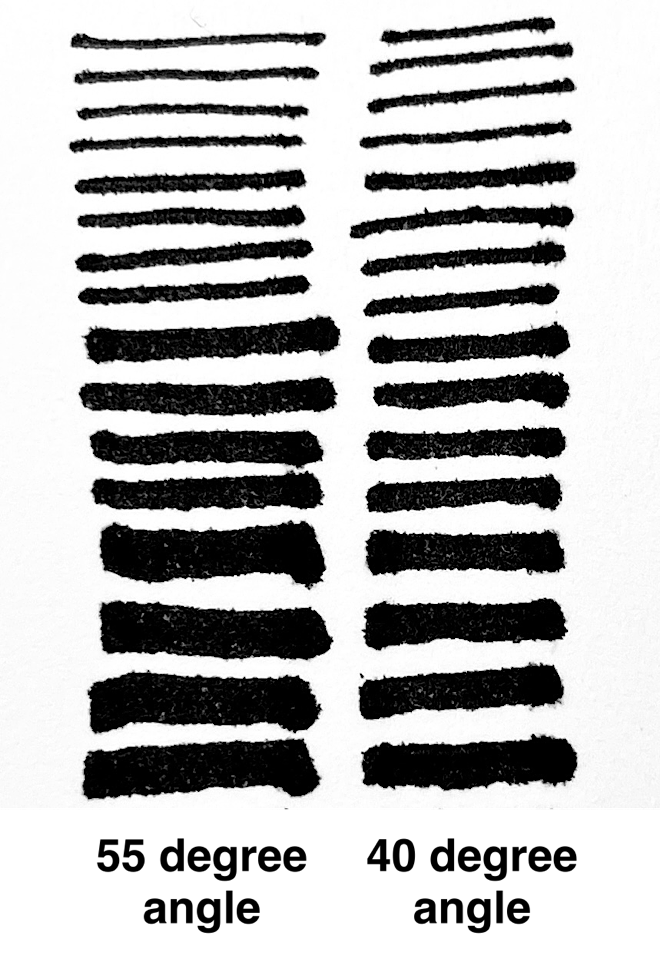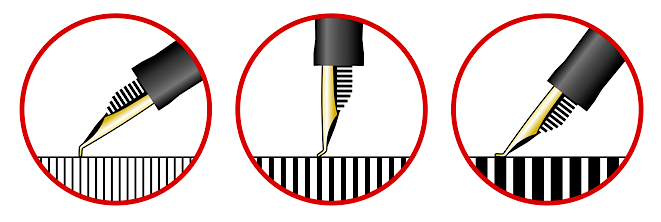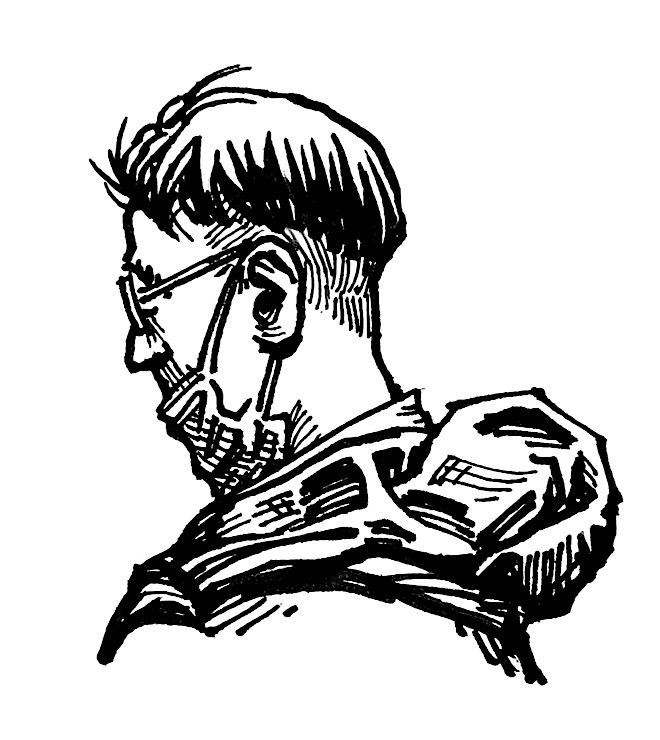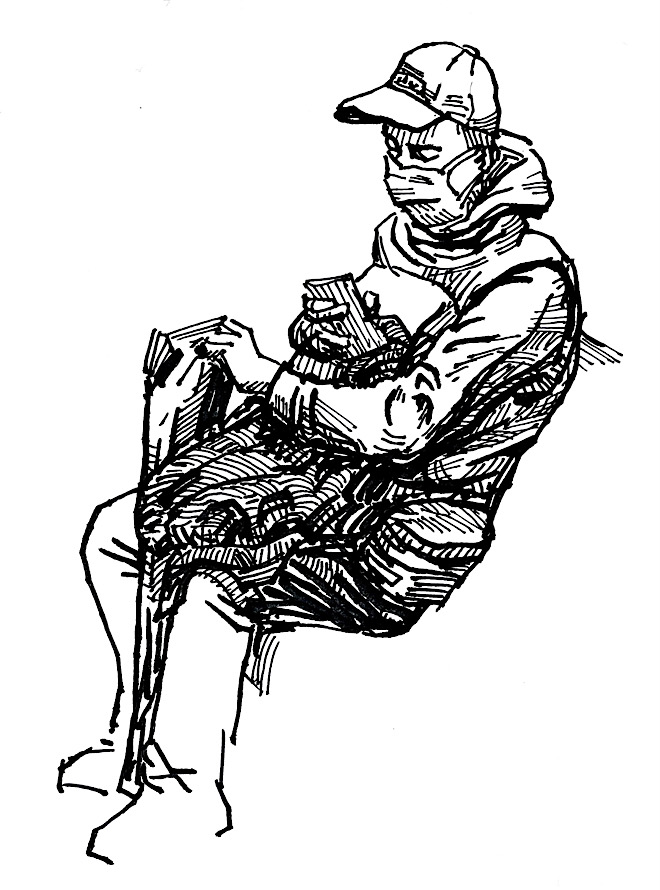 | ||
|
Page 2. Tools and materials For busy people who want to sketch (and who isn't busy these days?) You want to sketch, but maybe you are not able dedicate much time to it. Or maybe you simply find long sketching sessions tedious. No need to feel guilty; practically everything we enjoy in life becomes miserable or even harmful if taken to extremes. It's a matter of dosage. A small dose of sketching now and then can greatly enhance your life. You are the boss. Short sketching sessions of only a few minutes can be very fulfilling, and more enjoyable than long marathon sketch sessions. I confess I sometimes find it a challenge to fit sketch time into my schedule. I don't sketch every day, but manage to sketch just enough to keep a little art in my life. Looking back at the years since I took up sketching in the early 1970's, I can see many times when sketching was practically all I did or thought about; I was obsessed with it. Those times alternated with periods of little or no sketching at all, when other things pushed my art to the back burner. Sometimes these dry periods lasted for years. It's good to recognize that if there is a lot going on in your life, then your activity in sketching might resemble a pendulum; you will go back and forth. When you realize that you aren't sketching as you had in the past, don't throw away your supplies and think you have moved on. It's a good idea to keep a minimum of sketch tools handy for the moment when the spark returns and you find you are once again able to give a little more attention to your art. A tiny sketchbook and a few of your favorite sketch tools in your bag will call you when the pendulum starts to swing back. This section covers the particular tools I use in my sketching. Some are perfect for busy people (and some are not so perfect).
The pencil is still the most versatile sketching tool, and easiest to control. A mechanical pencil is even easier to use than the wooden ones that need to be sharpened. A mechanical pencil might help you to sketch more often and not worry about the results so much. Much of my pencil sketching is done on the train with fellow commuters as models. That means I have no time to think about what I'm doing, but just have to dive right in, often correcting and re-drawing as the model changes his or her pose. I can easily end up with lots of extra lines, and it can get pretty confusing, so I use a thin lead for fine lines. 0.5mm lead pencils For many years I've used 0.5mm leads which is the most common size for fine leads, and available in a wide variety of models from many companies. There are several wonderful pencils in the 0.5mm range such as Platinum's amazing OLEeNu It really works, and the lead won't break under normal writing conditions. I apparently draw with a heavy hand because 0.5mm lead would break frequently (every few seconds) in the past, but I have had no lead breakage problems with this pencil. However, if you are even more heavy handed than me (and I can't imagine that), Platinum has recently come out with the Oleenu Shield If you want a 0.5mm pencil with a nice eraser, there is the Faber Castell TK-FINE GRIP mechanical pencil. It has a nice long retractable eraser that extends with a twist. 0.3mm lead pencils Sometimes I get so sloppy that I end up with a tornado of confusing pencil lines which obscure details even with a 0.5mm lead, so I recently switched to a thinner 0.3mm lead for sketching train commmuters. There are still not that many options among 0.3mm pencils, but here are two 0.3mm mechanical pencils that are really useful. The first is the Pentel Graph Gear 1000 Drafting Pencil for 0.3mm lead I'm amazed at the fine detail I can get with a 0.3mm lead. I had previously thought that pencil leads this thin would simply give spider-web-like delicate lines with no life, but I realized that they are simply like using a freshly sharpened regular pencil which feels so good and makes such a nice line as dark as you need. At this size I have no problem drawing fine details even when I get sloppy. I went over to Amazon to read more about this pencil and judging from all the reviews and customer photos, it apparently has a cult following. There's a window that shows which level of lead hardness you have chosen, from 2H to 2B. It is an all metal pen, and seems indestructible. Everything about this pen is cool. This model also comes in a 0.5mm and 0.7mm version so you have to be make sure you are choosing the size you had in mind. The tip of this pencil is a long needle-like tube sleeve which is great for drafting because you can get the lead real close to a straight edge or French curve. For many years I had thought that the only draw back is that like practically every 0.3 mechanical pencil out there, the tube sleeve of the Graph Gear 1000 was not retractable, so it would catch on your pocket. But one day while reading some of the thousands of good reviews at Amazon, I was puzzled by those who praised this pencil's retractable tip! Finally I discovered that the tip does retract when you release the clip. I have one other 0.3mm mechanical pencil with a retractable tip, and that one is the Pilot FURE FURE SPRINTER It has a retractable tip and a unique mechanism for advancing the lead. You just give the pen a shake and a metal sliding spring inside the barrel bounces up and down, banging on something which makes the lead come out in increments. You can also click the pencil like a regular mechanical pencil, but that's not as fun. This one had been available in a 0.5 mm size size for a while The same pencil is also available under a different name, and comes in various colors with dots on the barrel. It's called the Fure Fure Corone
But I was happy to discover that the lead in this pencil almost never breaks, thanks to another cool feature: the metal tube sleeve which covers and protects the fragile lead is not stationary, but can slide. When you write at an angle, the tube is pushed back just enough for the tip of the lead to protrude and stay in contact with the paper. You can expose enough lead to do the job without breaking. The tube then slides back into the barrel as the lead gets shorter so you can use it for a longer period of time. When the lead and its protecting tube get too short, you just give the pencil another shake or click and the tube and lead are once again extended full length. It's an amazing pencil! The only disadvantage I have found with the Pilot Fure Fure is that the plastic clip is fragile, and will break easily. I threw away a few of these pencils and replaced them with new ones until I got wise and attached a metal clip from a disposable Sakura Micron pen that had run out of ink. The plastic nub of the clip that remains on the pencil will keep the metal clip from sliding off. Not so pretty, but very practical and strong. Both pencils have erasers on the end which are covered by a cap. I usually keep the eraser cap off my pencils so I can use the eraser without delay, but I keep it in place on the Pentel because the click spring mechanism is so strong, it sends the eraser and all the leads flying if there is no cap to stop them. There is now a mechanical pencil with an an even thinner lead. It's the Pentel Orenz Ultra Fine with 0.2mm lead! These leads break very easily, and goes without saying that this pencil requires a light touch! The instructions tell you to not advance the lead beyond the metal sleeve. Like the FURE FURE, this metal sleeve retracts as the lead gets shorter. These 0.2mm leads are much more expensive than thicker ones, and I'm reluctant to use -- and break -- these unnecessarily. I use mine sparingly for special jobs such as carefully drawing a subject accurately in pencil which will then be drawn over in ink. Thicker leads When I'm sketching at a more leisurely pace, I like to use a fatter pencil lead that gives more expressive lines than a 0.5mm or 0.3mm lead.
0.7mm and 0.9mm size leads don't break as easily, but also don't make the sharp fine line of a 0.3 or 0.5 lead. If you like to sketch in pencil but want a darker black line than what you get with graphite, try using a black colored pencil. It will give you lines as dark as ink. Some colored pencils are erasable and therefore as friendly as graphite pencils. 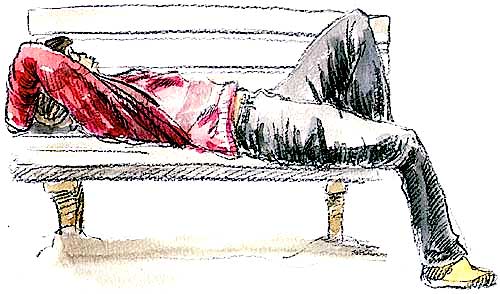 A lot of color pencils resist water very well such as the Berol Eagle black colored pencil which I used in the sketch above and added watercolor. Other colored pencils are water soluble and let you turn your pencil sketches into watercolor drawings with a brush and water. 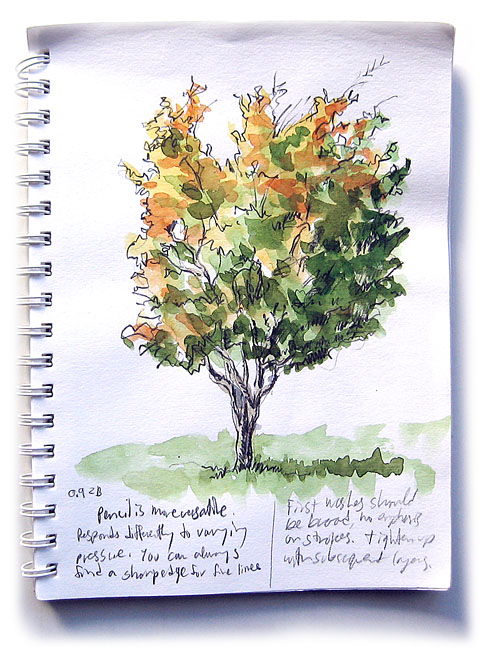 A tree done with a size 0.9 2B mechanical pencil and watercolors. This is also in the crisp line type style with no gray pencil shading. I don't do much light pencil shading, but stick to dark black lines. The sketch above was done with this ugly little pencil which was my absolute favorite for nearly twenty years.  It's a wood mechanical pencil, size 0.9 (0.9 millimeter leads) and I used it with 2B leads. I always carried this in my pocket. It used to be a full length pencil made by Ohto. I sanded off the shiny green paint, and sawed it down to 11.5 centimeters (4 3/8 inches) for portability. Finally it stopped working and would not accept any more attempts to repair it, so I went shopping for a new mechanical pencil, and found a few I think I like even better. Kokuyo makes a nice 0.9 mechanical pencil 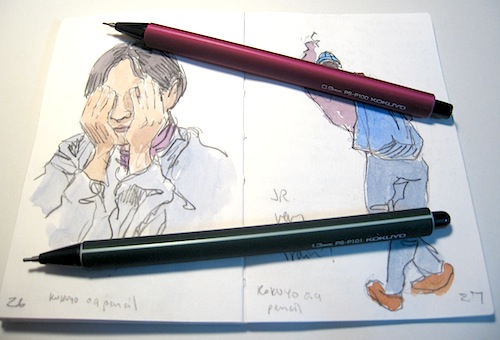 They also make a 1.3 pencil Several years after I bought these, I cut them down because I really wanted a short sketching pencil to replace my beloved ugly one. Fortunately it was easier than I had anticipated because soft material can be cut with a cheap craft knife (a.k.a. cutter knife). First, I took them apart to see how much room I needed for the leads, then I cut down the outer shell, followed by the inner plastic tube. I cut the exact same amount off of both parts. Then I inserted the black plastic end piece into the shorter inner tube. The tube originally had square openings to lock in place the tabs on the black end piece, but I don't think they are necessary. It actually worked. Later, when I measured them, these pencils were exactly the same length as their old ugly short ancestor which had died on me so long ago. Now that I know how easy it is to disassemble these pencils, (just unscrew the black cone tip) I went ahead and plugged up the hole on that black end piece with white craft glue (PVA) so the leads won't fall out anymore.  By the way, before I attempted this modification, I had to clean up the rubbery surface of these pencils which had become gummy and sticky. First I rubbed them down with a tissue paper and lighter fluid (I used a cheap zippo oil knock-off), then I followed up with a tissue paper and ethanol. For larger sketches, I found a wonderful mechanical pencil with even fatter leads. I have not attempted to cut it down to a shorter length. It's from an old Japanese pencil company in Tokyo, KITA-BOSHI (North Star) who wanted people to return to the joys of using a traditional wood pencil, so they made this one called OTONA NO ENPITSU This pencil was an instant hit and won the "stationery item of the year" award in Japan. I used 2mm leads many years ago in art school and always thought they were fantastic for sketching.
This new pencil is much lighter, similar to a real wood pencil, and advances the lead in increments with clicks of the button like a mechanical pencil. I also carry a tiny Uni Lead pointer Of course, the traditional wood pencil is still widely used by those who don't mind all the wood shavings that come with sharpening them. If you want to try leads that are fatter than 2.0mm, they are available from 3.0mm up to 5.8mm. I have written a separate article on these fatter leads. 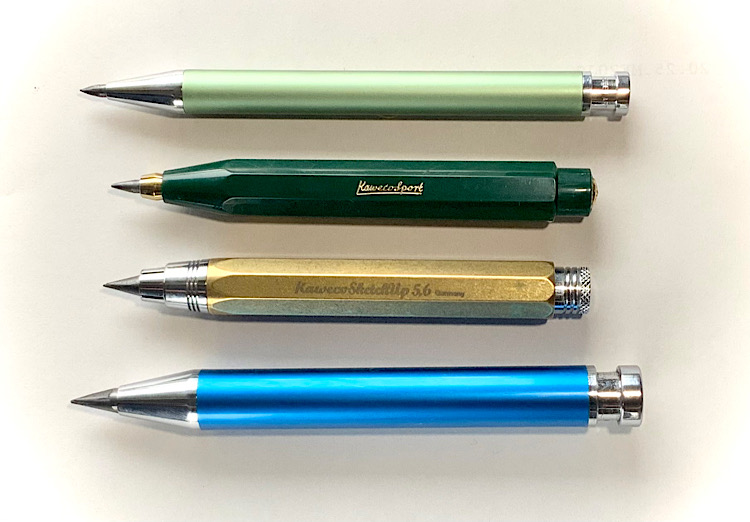
There are even fatter leads than this, but far as I know, they are intended to be held directly in the hand rather than used in a mechanical pencil or lead holder because at that size, they are practically the same diameter as pencils. Colored Pencils I've already mentioned black colored pencils for dark black lines, so I need to mention the other colored pencils. If pencils are the easiest, most intuitive sketching tools, then it stands to reason that for color sketching, colored pencils would also share this distinction. There is no juggling of brushes, paints or palettes, and nothing to clean up afterwards. And most people already have experience using colored pencils, so there is not that much to learn; just jump right in! If you do a web search, you will discover amazing examples of how far some professional artists have gone with colored pencils alone, particularly photo-realistic works of art. So the colored pencil is definitely not just for kids; it's a serious art tool for professionals as well, for sketching and finished art. The only drawback to sketching on location with colored pencils is that each color requires its own pencil (although blending can create even more colors). You can end up going out to sketch with a pocket or bag stuffed full of colored pencils. And this is what a lot of artists do. However, if you can sketch with a limited number of colors and blend those colors to make new colors, then you can do all your sketching with one pencil and a sketchbook, which has got to be the ultimate compact color sketching kit. Pentel (a.k.a. Pentel Arts) makes a just such a tool: a multi-color pencil called the Multi 8  I could go on here about this exciting tool which has actually been around for a long time, but I have written a separate article on this called The Pentel Multi 8 Colored Pencil. Pen and Ink Nothing beats pen and ink for clean, crisp line work, especially if you do a lot of hatching. The traditional tool for this ink sketching is the dip pen and bottle of ink, preferably waterproof India ink if you are going to cover the drawing with watercolor. Of course, a dip pen is a bit messy for sketching outside. You could borrow an idea from the Japanese. For centuries Japanese writers and artists have a used a spill proof brush and ink carrier called a "yatate" which has an ink pot filled with cotton or silk which has been saturated with ink, but not to the point of dripping. You could do the same thing with a film canister filled with cotton and saturated with ink. Then you could dip a pen in the ink and not worry about spills if the whole thing gets knocked over. But you will need to clean the pen when you are finished, which makes a dip pen a bad choice for the busy sketcher. Some dip pens have amazingly flexible nibs, some are so flexible they are very difficult to use without some practice.  Dip pens make their best lines when using down strokes. Up strokes can make scratchy lines or even cause the tines to catch on the paper, causing a mess. You have to vary the position of your hand to get the best angles for the best strokes. Also, dip pens leave a bead of ink on the surface of the paper that takes a while to dry. It's very easy to forget this and smear ink all over the drawing with your hand. For many years, since my high school days I used a 102 "Crowquill" Today, most manga artists use a flexible G Pen Nib It's fun to collect various pen points and holders, and when you dip a pen in ink and start to use it, you become part of a tradition that goes back for thousands of years.
Fountain pen inks are thin so they can travel through ink channels in fountain pens without clogging, but with a dip pen these inks will feather (spread out) and bleed through notebook paper. After trying several brands of bottled ink, I settled on Platinum's blue black The Amazon link will take you to a Japanese vendor who (when I last checked) transliterated the Japanese name directly into Roman characters: Purachinaman'nenhitsu ink (Platinum fountain pen ink). Fountain pens Many pen and ink sketchers choose fountain pens for sketching. These are very portable and convenient and still retain that old traditional feeling. Some come with semi flexible nibs, but no modern fountain pen nib can match a dip pen for flexibility. If you want extreme variation in line width you will have to use a dip pen or brush. In the early 20th century a lot of fountain pens had very flexible nibs. However, with the advent of the ballpoint pen (biro) people changed their writing habits and began applying much more pressure in order to get a decent line. This extra pressure will ruin a delicate flexible fountain pen nib. But most modern fountain pens -- even cheap ones -- have strong suitable nibs for fast sketching. Fountain pens also work best when using down strokes like dip pens, but because most fountain pens have a ball of tipping material on the end, the issue is not as great. This tipping material is usually made of a combination of iridium and osmium or some other hard metals. It serves to protect the tip from wear since lot of fountain nibs are made of gold, and are not disposable like dip pen nibs. There are fountain pens which are marketed as drawing pens such as the Rotring ArtPen Most fountain pen inks are watersoluble which will allow you to get some great artistic effects if you use a little water in a brush to draw out the ink from the lines and use it like a watercolor wash. Waterproof fountain pen ink If you want to paint watercolors over the ink drawing without dissolving the ink lines, you will need to use waterproof fountain pen ink. You can't put regular drawing ink such an India ink in a fountain pen because it can dry up inside the ink channels and under the nib and ruin the pen.
Platinum Carbon ink comes in a bottle, Sailor Kiwa-Guro also comes in a bottle, Noodler's ink comes only in a bottle All three are great drawing inks, but I usually buy Platinum ink rather than Noodlers simply because I live in Japan, and Platinum Carbon Ink cartridges are sold everywhere, even down the street at the local neighborhood store. I also have a box of Sailor ink cartridges, but most of my pens are Platinum, so the Sailor ink doesn't see as much action. I would recommend that you only use these waterproof inks in a pen especially designed for these inks, or a fountain pen that could easily be taken apart and thoroughly cleaned, or a cheap fountain pen that can be easily replaced. For many years I used Platinum Carbon ink in a special fountain pen by Platinum called a Carbon Pen which had a larger ink channel for their carbon ink so it won't dry out as easily. Also, the soft plastic slip-on cap made an airtight seal so the ink did not dry out when it was not being used. But It appears that this pen has been discontinued, possibly because with the advent of Platinum's airtight "Slip and Seal" caps, a pen dedicated to Carbon ink was no longer necessary. The Platinum 3776 CENTURY and Carbon Ink Platinum has redesigned one of their flagship model fountain pens to accomodate Carbon ink! They took their 3776 fountain pen and gave it a new nib and ink feed and also came up with a new screw-on cap which becomes air-tight after you screw it on. They renamed it the Platinum "#3776 CENTURY  This pen had been on the market for a few years when I discovered it, and I immediately ordered a black one with an extra fine nib and a translucent wine colored one (a.k.a. Bourgogne) with an ultra extra fine nib since I do a lot of fine pen hatching in my drawing. The ultra extra fine seems to be the closest to the Carbon pen extra fine nib, and the best choice for fine hatching. The extra fine nib is my personal choice for general drawing. Platinum clearly states that these pens were specially designed to be used safely with pigment inks, and Carbon ink is a pigment ink, as is Sailor Kiwa-Guro. I inserted Carbon Ink Cartridges and have used these pens for drawing and writing, and I've had no trouble at all! So now I can carry a beautiful fountain pen with a Carbon Ink cartridge in my shirt pocket, and have any nib type I like. Yes, this is a dream come true. Converters
Up until the late 1950s there was no such thing as an ink cartridge for fountain pens, and all fountain pens used bottle ink via a filling system such as rubber ink sac with squeeze bar or piston with rotating knob. Fountain pens with filling systems are still very popular with pen aficionados, but ink cartridge type fountain pens are more popular with general pen users who don't want to bother with filling pens from a bottle. If you want to use Noodler's ink in your cartridge type fountain pen, or if you want to use Platinum or Sailor inks in a fountain pen from a different maker, you can still do so if you have an ink converter. Ink converters fit in the pen in place of a cartridge and have filling systems, usually with a piston or squeeze bar so you can use any maker's bottle ink with your fountain pen. Some pen companies make converters and cartridges that will only fit their particular pens, but many companies use a standard size cartridge called International or European, and their converters are also usually interchangeable. Waterman, Pelikan and MontBlanc are among these companies. Bent nib fountain pens
These are also called fude nib pens, and they can get a variety of line widths. Fude (foo-deh) is the Japanese word for brush, but the only thing these pens have in common with brushes is the fact that you can hold them perpendicular to the paper like a brush. These unique nibs can get a few line widths by varying the angle. That ability to get both fine and broad lines can make a big difference in an ink drawing. The Fude DE Mannen pen I think it's ironic that this type of pen is commonly known by its Japanese name because practically the only fude nib pen you can find in Japan is Sailor's Fude DE Mannen I have written more about this pen in my article The Fude DE Mannen 
These are available in two nib angles, 40 degrees and 55 degrees.
You get the thinnest line from turning the nib upside down and using the reverse side of the nib. Then you get a few different line widths from the regular side (underside) of the nib as you lower the angle. Finally you get the broadest line when the entire flat surface of the nib is in contact with the paper. As the photo shows, you can get the same range of stroke widths from either the 55 degree nib or the 40 degree nib, depending on the angle you hold the pen itself. As with most fountain pens, you can also quickly lift the nib off the paper to get a short tapered line. And a single pen that gets several line widths will be valuable for quick expressive sketches.
Two ink cartridges of Sailor water-soluble black ink came with this pen. You can also use a Sailor Fountain Pen Converter  Chinese bent nib pens While there seems to be only one Japanese company that makes this type of pen, many Chinese companies make them. Of course, Chinese pen sellers don't usually call these pens by their Japanese name, but instead call them calligraphy or bent nib pens. But that doesn't alleviate the confusion since a calligraphy pen is something entirely different in the west, and a bent nib could mean a damaged pen. Duke 209 One very popular Chinese bent nib pen is the Duke 209 which is often mentioned by artists on YouTube. This pen is slim and fits in the pocket nicely. 
The bend in the nib is more curved than the Sailor which has a pretty abrupt bend, and I found I could get a smoother transition between thin and thick lines with this pen. Below is an on-the-spot sketch done with the Duke 209 fude nib pen. 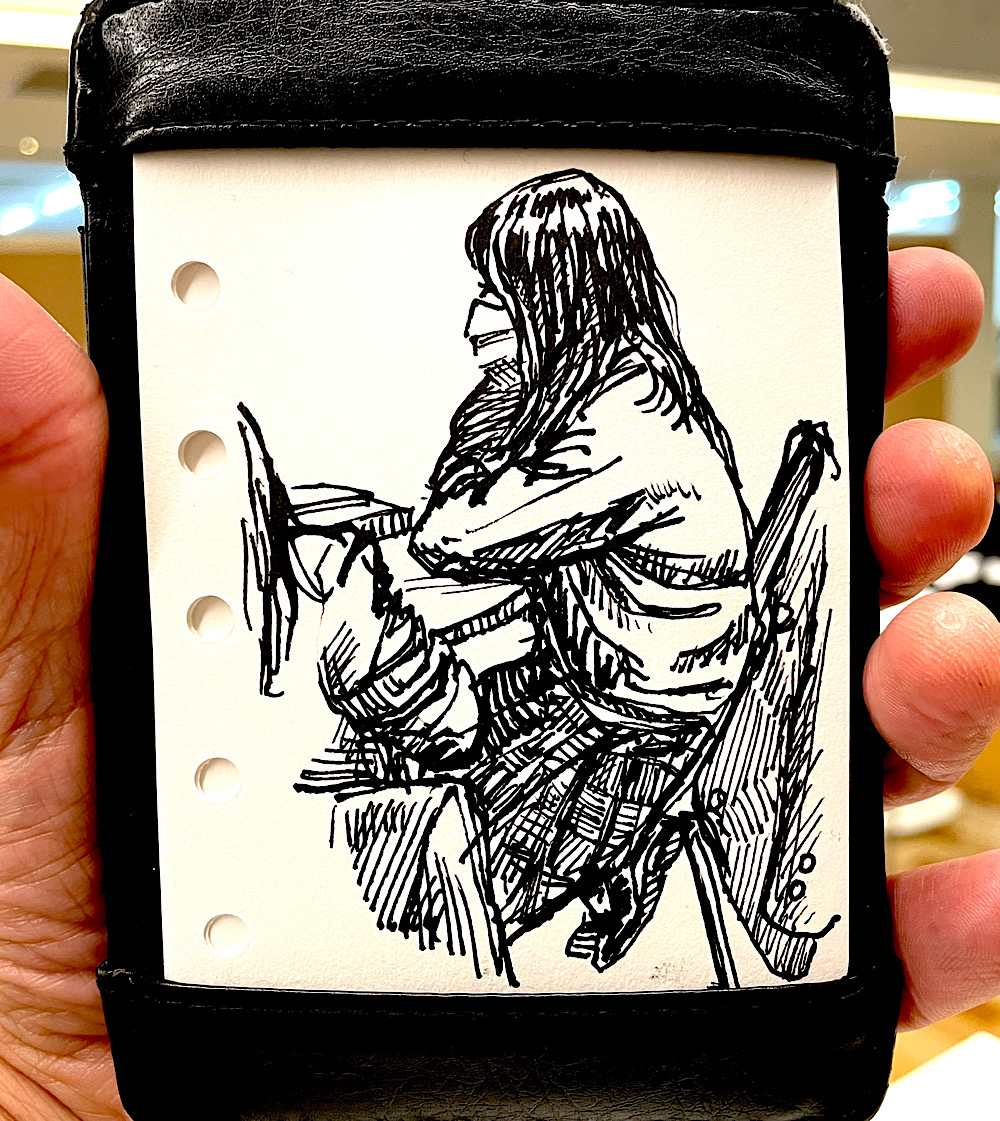
I love how I can get thick expressive lines and tight thin hatch lines with the same pen even on a very quick sketch where there is no time to think. I have several other Chinese bent nib fountain pens, and you can read more about them in my article Enter the Chinese bent nib fountain pen Disposable pens By far the most popular ink sketching tools today are disposable pigment pens. They come in a variety of nib sizes and make a very black permanent line that is completely waterproof when dry. You can also draw in any direction and angle and get a consistent line. 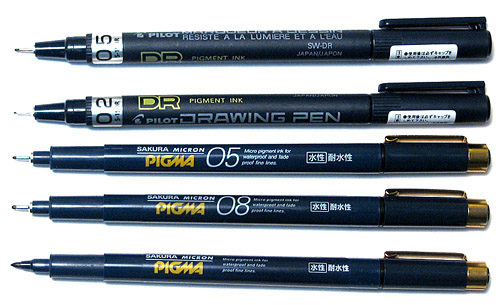 Several companies make these, and they are easily obtained. One popular brand is the Sakura Pigma Micron pen When these disposable pens run out of ink, make sure you save the metal clip; they are actually removable. These are very useful for attaching to pencils or pens which have lost their fragile plastic clips. I was able to save my Pilot Fure Fure mechanical pencil this way when its plastic clip broke off. 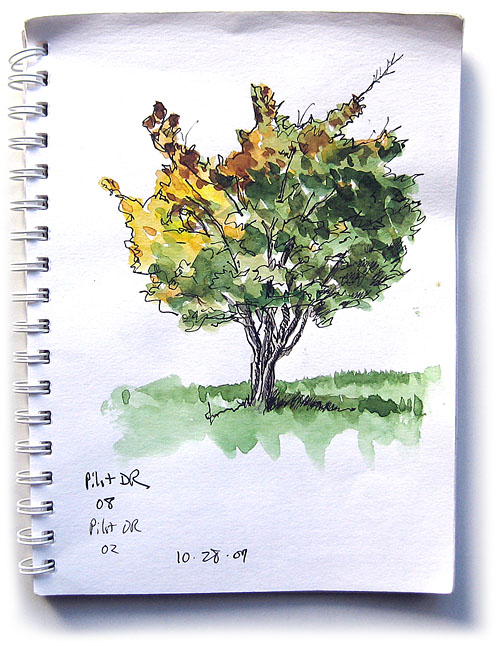 This tree was done with Pilot DR pigment ink drawing pens, sizes 08 and 02, and watercolor. It's the same tree as the one done in pencil above, and the drawing style is the same as well. I did these two sketches just to compare the pencil and pigment pen. |
Next page >> |
 |
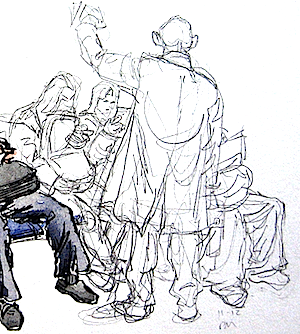 Mechanical Pencils
Mechanical Pencils



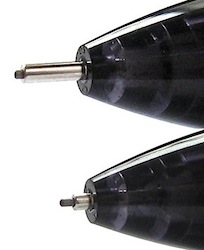 It goes without saying a 0.3mm lead can break more frequently, especially if you use a lot of pressure to get a dark line, as I do. So the shake mechanism will let you advance the lead without interrupting your work.
It goes without saying a 0.3mm lead can break more frequently, especially if you use a lot of pressure to get a dark line, as I do. So the shake mechanism will let you advance the lead without interrupting your work.
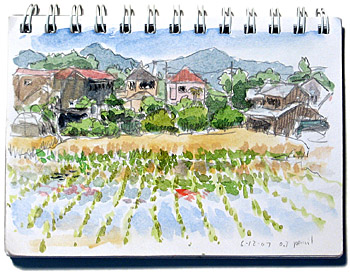
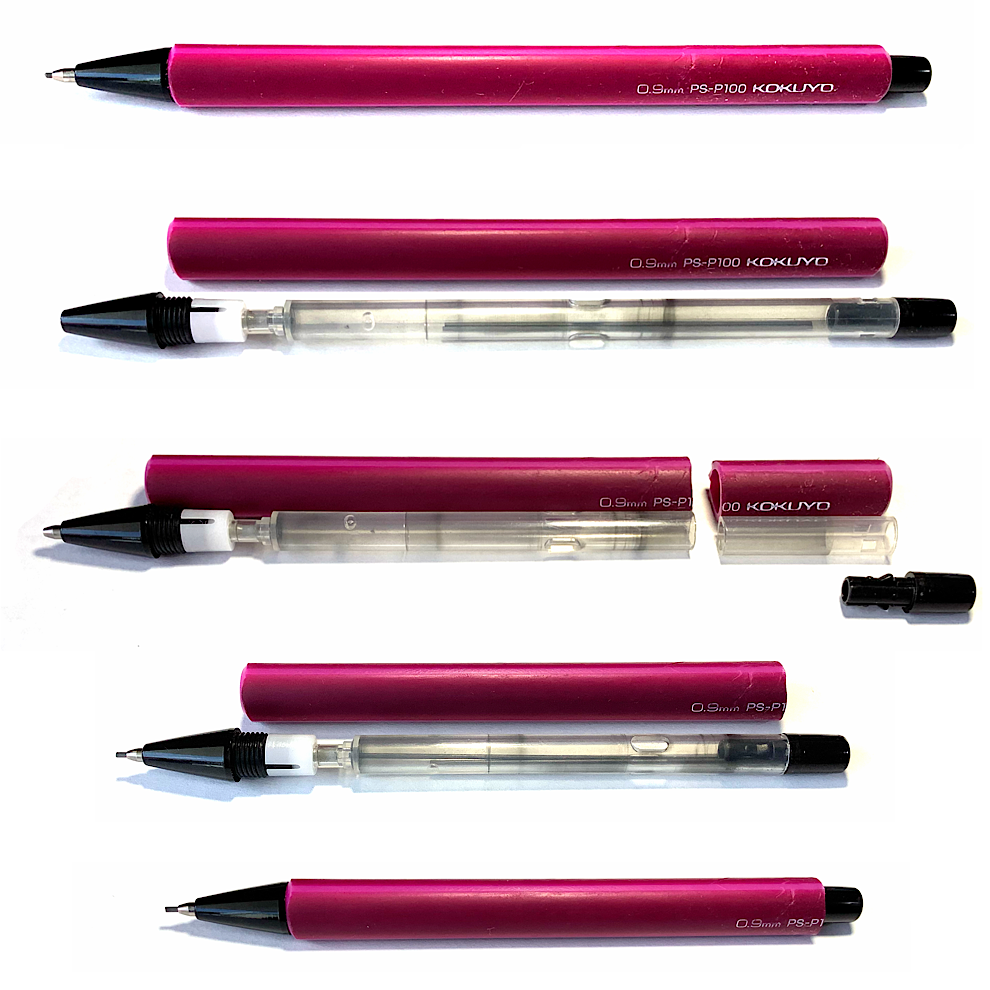


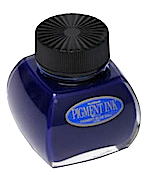

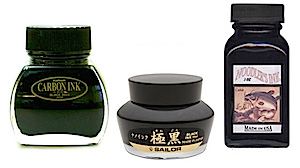 There are several brands of waterproof fountain pen ink today, and I have tried three:
There are several brands of waterproof fountain pen ink today, and I have tried three: 
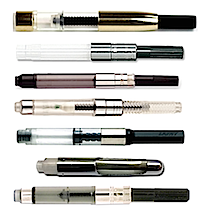 As I mentioned above, Noodler's Black ink does not come in cartridges, but only in bottle form.
As I mentioned above, Noodler's Black ink does not come in cartridges, but only in bottle form.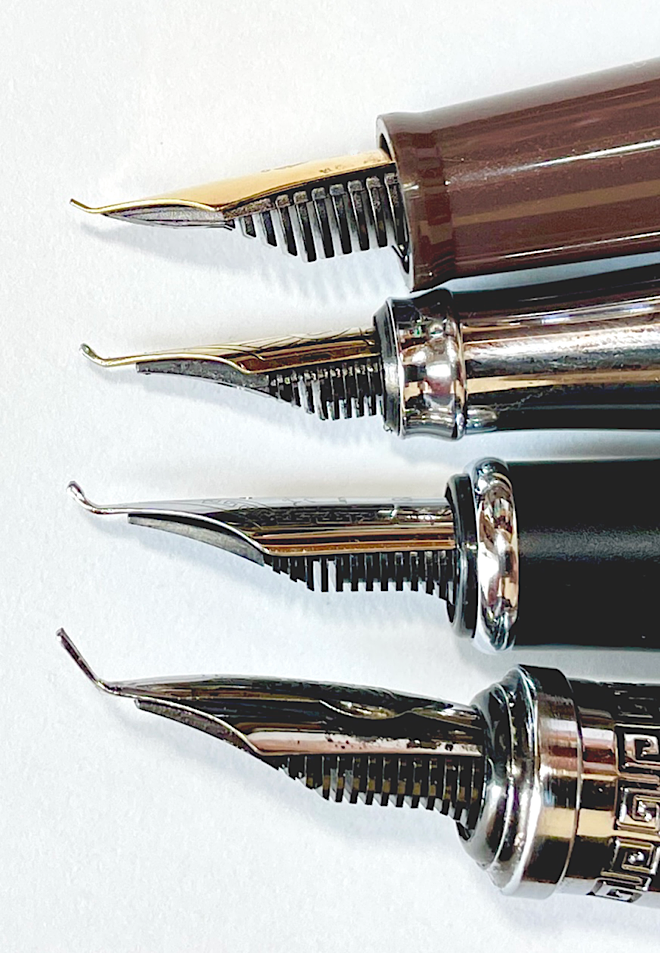 Bent nib fountain pens are very popular with urban sketchers.
Bent nib fountain pens are very popular with urban sketchers.